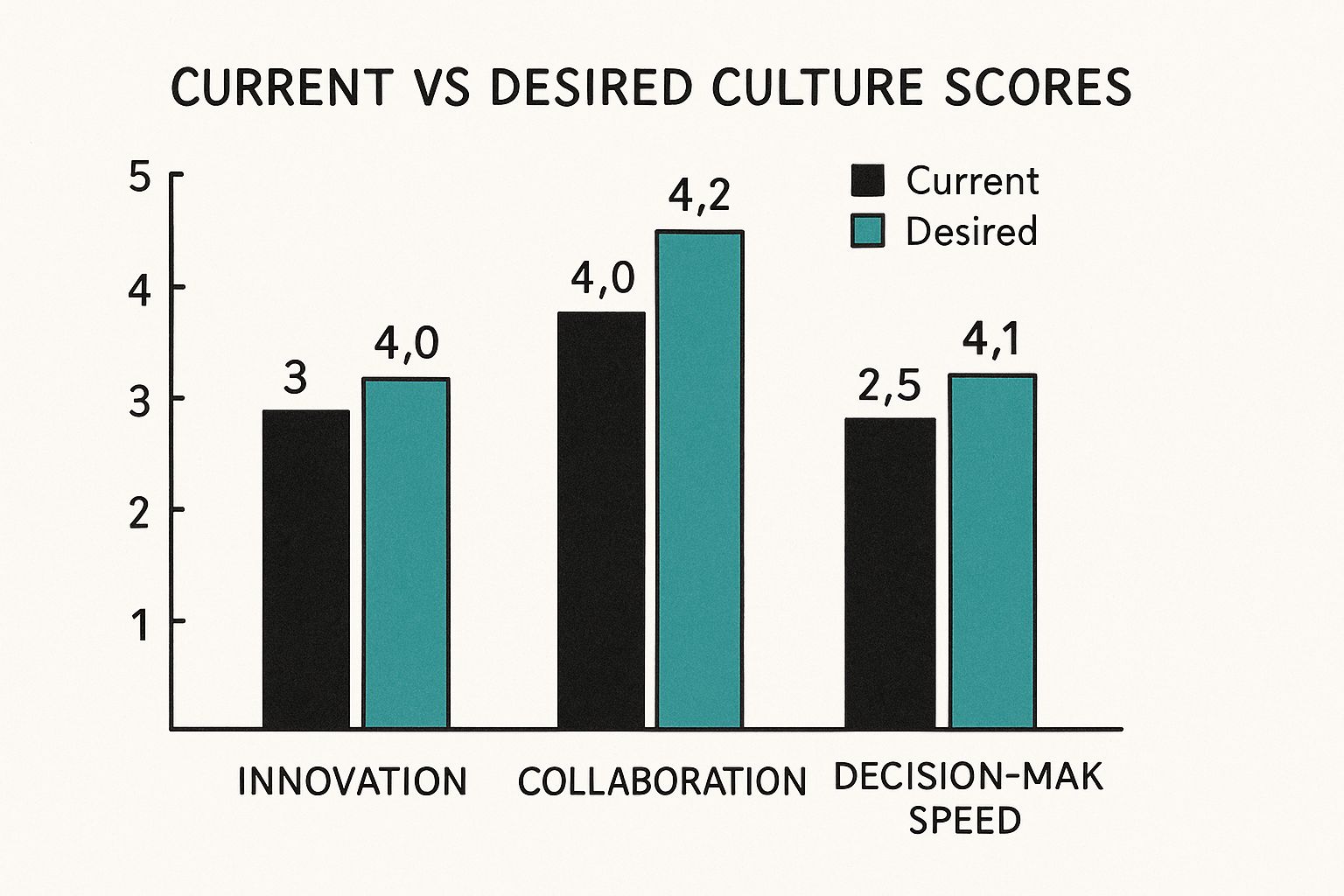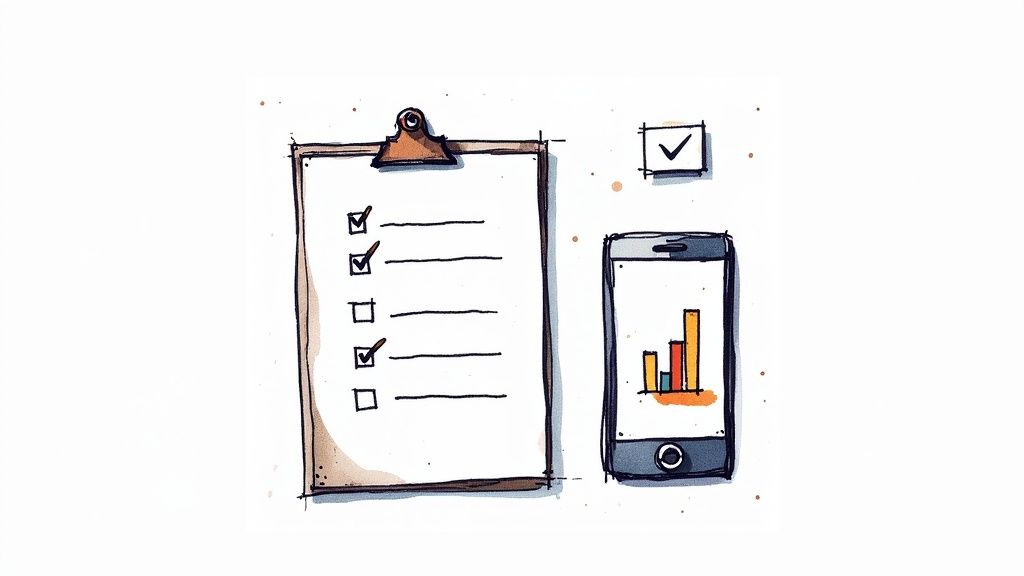A Guide to Assess Organizational Culture

To truly understand your organizational culture, you have to go deeper than the surface-level perks and mission statements. It's about measuring the real, lived experience of your team—the underlying values, beliefs, and behaviors that dictate how work actually gets done. This isn't just about what's written in the employee handbook; it's about diagnosing how people interact and whether their daily actions genuinely align with your company's goals.
Why Assessing Your Culture Is a Business Imperative

For a long time, culture was seen as a "soft" HR initiative. That view is officially outdated. Ignoring your company's culture today comes with a very real business cost, and actively assessing it has become a core strategic function with a direct impact on performance, retention, and your bottom line.
While culture can feel intangible, it is absolutely measurable—and manageable.
The need for this has never been more urgent. According to Gallup's 2023 "State of the Global Workplace" report, employee engagement stands at just 23%, and low engagement costs the global economy an estimated $8.8 trillion.
On the flip side, organizations with a strong, connected team culture see a massive payoff. A report by BetterUp found that employees who feel a high sense of belonging are 3.5 times more likely to be productive and are 50% less likely to turn over. The numbers don't lie.
The Business Case for Culture Assessment
This table breaks down how a well-managed culture directly fuels critical business outcomes. It’s not about fuzzy feelings; it’s about tangible results.
| Business Area | Impact of Positive Culture | Supporting Source & Statistic |
|---|---|---|
| Employee Retention | Creates a sticky environment that makes top performers want to stay, significantly reducing costly turnover. | Companies with a strong culture experience up to 72% lower turnover rates. (Human Synergistics International) |
| Productivity & Profitability | Engaged employees are more focused, innovative, and committed, driving efficiency and better financial results. | Highly engaged teams show 21% greater profitability. (Gallup) |
| Customer Loyalty | Happy, empowered employees deliver superior customer service, creating brand advocates and repeat business. | Companies with engaged employees see a 10% increase in customer ratings. (Gallup) |
| Talent Attraction | A positive reputation for culture becomes a powerful recruiting tool, attracting high-caliber candidates. | 86% of job seekers would not apply to a company with a bad employer reputation. (Glassdoor) |
By connecting the dots between culture and these core metrics, it's clear that assessment isn't just an audit—it's a fundamental part of a healthy business strategy.
Driving Tangible Business Outcomes
A healthy organizational culture is a powerful engine for business success, directly impacting everything from daily operations to improving sales productivity. When you start treating culture assessment as a vital diagnostic tool, you can pinpoint issues before they spiral out of control, turning vague feelings into hard data you can act on.
A proactive approach to culture assessment allows you to move from reacting to problems like turnover and disengagement to building an environment where top talent thrives. It’s about building a resilient organization from the inside out.
Thinking about culture in these terms helps clarify its business impact:
- Higher Employee Engagement: When an employee's personal values align with the company's, their motivation and commitment just naturally follow.
- Lower Turnover: A positive, supportive environment is a huge reason people stay. It creates a workplace that top performers simply don't want to leave.
- Improved Customer Satisfaction: It’s a simple formula: happy, engaged employees provide better service, which creates happier, more loyal customers.
Ultimately, a thorough assessment gives you a clear roadmap for what to improve and where to double down on what’s already working. If you're ready to build out a complete framework, our organizational culture assessment guide for modern companies offers a much deeper dive into the nuts and bolts of the process.
Getting Started: The Foundation of a Real Culture Assessment
Before you even think about sending out a survey, we need to talk about what happens first. A truly useful culture assessment isn't just a task to be completed; it's a strategic move. The whole process really begins with getting clear on your goals, securing genuine support from the top, and knowing exactly what you're trying to figure out.
This initial phase is all about building a solid foundation. If you skip it, you're likely to end up with a pile of data that's confusing, impossible to act on, or—worst of all—completely ignored. The point isn't to just check a box. It's to connect this effort to real, tangible improvements in the business.
Figure Out Where You Are and Where You're Going
First things first: you need a clear picture of the gap between your culture today (your "current state") and what you want it to look like in the future (your "future state"). This isn't just wishful thinking. It has to be tied to actual business problems you're facing.
For instance, if your company is bogged down by slow decision-making, your ideal future state might be a culture where front-line managers feel empowered to make calls and are rewarded for solving problems on their own.
Going through this exercise forces you to ask some tough, strategic questions:
- What business problems are we actually trying to fix here? Is it high turnover? A lack of new ideas? Departments that don't talk to each other?
- Which of our company values are we not living up to? If we say we value transparency, where is that falling short?
- What specific behaviors do we need to see more of? What do we need to see less of?
Answering these gives you the laser focus you need to design a great assessment. If you're looking for help crafting the right questions, our culture survey guide has some great, practical tips for measuring what matters.
Get Your Leaders on Board and Build Your Crew
This is a dealbreaker: you absolutely must have genuine buy-in from your leadership team. And I don't just mean they sign off on the budget. They need to be visible champions of the entire process. That means they're ready to hear the good, the bad, and the ugly, and they're committed to putting resources behind making changes based on what you find.
A culture assessment without leadership commitment is a recipe for cynicism. If your people feel like their feedback is just going into a black hole, you'll never get the honest insights you need.
Once your leaders are truly committed, pull together a cross-functional team to run the show. Make sure you have people from different departments, levels, and even different lengths of time with the company. This helps you get a 360-degree view, not just the perspective from the executive suite or HR.
This foundational work is more important than ever in today’s talent market. Research from Glassdoor found that 77% of adults across four countries would consider a company's culture before applying for a job there. And for the newest generation entering the workforce, a study by the Adecco Group revealed that 2 in 3 Gen Z workers rank a positive work culture as a top priority. As you can see from these company culture statistics and their impact on business success, getting your culture right isn't just a "nice-to-have"—it's a massive strategic advantage.
Choosing the Right Lens: How to Select a Culture Assessment Framework

So, how do you actually measure something as squishy and complex as company culture? Going with your gut just won’t cut it. To get a real, objective look at what’s going on, you need a structured model—a framework that gives everyone a common language to talk about what truly matters.
Think of it this way: established frameworks bring a dose of science to the art of culture. They help you move beyond subjective opinions and start gathering objective data. These models are essentially blueprints for understanding the deep-down dynamics of how your company works, competes, and grows.
A Look at the Competing Values Framework
One of the most trusted and battle-tested models out there is the Competing Values Framework (CVF), developed by Robert Quinn and Kim Cameron at the University of Michigan. It’s the engine behind the popular Organizational Culture Assessment Instrument (OCAI). The CVF is brilliant in its simplicity, mapping cultures across two key spectrums:
- Internal Harmony vs. External Competition: Is your company more focused inward on its people and processes, or is its gaze fixed externally on the marketplace and beating the competition?
- Stability and Control vs. Flexibility and Freedom: Does your organization run on rigid structures and predictability, or does it thrive on agility, autonomy, and letting people run with new ideas?
Plotting your organization on these two axes reveals four distinct quadrants. Just figuring out where you are now—and, more importantly, where you want to be—is an incredibly powerful first step for any kind of meaningful change.
The Four Primary Culture Types
The CVF breaks down culture into four main archetypes. Most companies are a mix, but there’s almost always a dominant style or two that defines their DNA.
| Culture Type | Core Focus | What It Feels Like | Best Suited For |
|---|---|---|---|
| Clan | Collaboration | A friendly, tight-knit workplace that feels like a big family. Leaders are seen as mentors, and loyalty runs deep. | Environments where teamwork and high employee morale are everything. |
| Adhocracy | Creation | A dynamic, entrepreneurial, and creative hub. People are encouraged to innovate, experiment, and take calculated risks. | Fast-moving industries where constant innovation is the key to survival. |
| Market | Competition | A results-obsessed organization focused on winning. Hitting targets, gaining market share, and building a powerful reputation are the main drivers. | Highly competitive sectors where being #1 is the ultimate goal. |
| Hierarchy | Control | A formal, structured environment governed by clear procedures. The focus is squarely on stability, efficiency, and predictability. | Stable, regulated industries where consistency and minimizing risk are critical. |
For instance, a fast-moving tech startup may lean heavily into the Adhocracy quadrant to drive innovation. In contrast, a large financial institution will likely exhibit strong Hierarchy and Market traits to ensure regulatory compliance while staying competitive.
Choosing a framework isn't just a box-ticking exercise. It’s about picking the right lens to see your organization’s unique challenges and strategic goals more clearly. The right model makes the intangible, tangible.
The Denison Model is another fantastic option. It zeroes in on how culture drives performance through four specific traits: Mission, Adaptability, Involvement, and Consistency. Denison's research directly connects these cultural elements to bottom-line results like profitability and sales growth.
As you start using these frameworks to assess your organization, you'll uncover powerful insights that extend far beyond internal strategy. This understanding is crucial for improving how you evaluate culture fit during the recruitment process and ensuring you hire people who will truly thrive.
Ultimately, the best framework for you is the one that directly supports your business goals. Are you trying to spark more innovation? A model focused on Adhocracy is probably your best bet. Need to iron out inefficiencies? A Hierarchy-based assessment will give you the clarity you need.
Gathering Honest Feedback with a Mixed-Methods Approach
If you want to truly understand your company's culture, you can't just rely on a single annual survey. The real, actionable insights come from what we call a mixed-methods approach. Think of it as combining the "what" from quantitative data with the "why" from qualitative feedback. This blend is what gives you a complete, 3D picture of what’s actually happening on the ground.
Relying on just one method can give you a false sense of security. Companies with glowing engagement scores can be completely blindsided by frustrations brewing in a key department. Combining broad-stroke data with deep-dive conversations is the only way to catch those critical nuances before they become major problems.
Blending Numbers with Narratives
Quantitative tools are fantastic for getting a bird's-eye view. Things like anonymous employee surveys and quick, frequent pulse checks give you measurable data across the entire organization. They help you spot broad trends—like a company-wide dip in perceived psychological safety or a jump in satisfaction after you roll out a new remote work policy.
But numbers don't tell the whole story. They can't capture the human experience behind the percentages. That’s where qualitative methods become your best friend.
Here are a few of the most effective qualitative tools in practice:
- Confidential Focus Groups: These small, guided discussions are perfect for exploring specific issues that pop up in your surveys. Let's say your survey data shows low scores on "inter-departmental collaboration." A focus group can uncover the root cause. Is it a technology barrier? Conflicting team goals? Or a few personality clashes gumming up the works?
- One-on-One "Stay" Interviews: Most companies do exit interviews, but by then, it's too late. Stay interviews are proactive conversations with your top performers about what keeps them there. These talks are a goldmine for understanding what your culture gets right and what makes your best people feel truly valued.
- Observational Analysis: This sounds simple, but it’s incredibly powerful. Just pay attention. How do people interact in meetings, in the breakroom, or on Slack? Does the loudest person in the room always win the debate, or are quieter team members actively encouraged to share their thoughts? These observations reveal the unspoken rules of your culture.
For a really well-rounded view, especially on an individual level, many leaders use tools like 360-degree feedback form templates. Getting input from a person's manager, peers, and direct reports provides a much fuller picture of their impact on the surrounding culture.
To help you decide which tools are right for your situation, it’s useful to compare them directly. Each method has its own strengths and weaknesses.
Comparison of Culture Assessment Methods
| Method | Type | Best For | Potential Pitfall |
|---|---|---|---|
| Annual Surveys | Quantitative | Benchmarking year-over-year trends and company-wide sentiment. | Can be too infrequent; may miss fast-emerging issues. |
| Pulse Surveys | Quantitative | Tracking real-time reactions to specific changes or initiatives. | Survey fatigue if overused; lacks deep context. |
| Focus Groups | Qualitative | Deep-diving into specific problems identified in quantitative data. | Can be influenced by group dynamics or a dominant personality. |
| Stay Interviews | Qualitative | Understanding what keeps top performers engaged and loyal. | Time-consuming to conduct across the entire organization. |
| Observation | Qualitative | Uncovering unspoken norms and "how things really work around here." | Prone to the observer's personal bias if not done systematically. |
Ultimately, a combination of these methods will give you the most reliable and comprehensive view of your workplace culture.
Interpreting Conflicting Data
So, what do you do when your data seems to contradict itself? For instance, your survey results show employees feel highly innovative, but your focus groups reveal a deep-seated fear of failure that kills new ideas.
This isn't a failed assessment—it's a critical insight.
This kind of conflict often points to a gap between the espoused culture (what leadership says and what everyone agrees is important) and the enacted culture (what people actually do and what gets rewarded day-to-day).
This image illustrates that gap perfectly. It visualizes the difference between employees' current experience and what they truly want from their culture, highlighting where to focus your efforts.

You can see that while collaboration is a relative strength, there’s a major disconnect when it comes to the desire for more innovation and quicker decision-making. That's your roadmap for improvement.
When your data tells two different stories, dig deeper. This conflict is often where your biggest opportunities for cultural improvement are hiding. It signals a disconnect between leadership's intent and the team's everyday experience.
By embracing this layered, mixed-methods approach, you move beyond surface-level stats and start to genuinely understand your organizational culture in all its messy, human complexity.
Translating Raw Data into Actionable Insights

Collecting the data is often the easiest part. The real work—and where the value truly lies—begins when you start turning those raw numbers and qualitative notes into a clear path forward. Once your surveys are in and your focus groups have wrapped up, you’re sitting on a goldmine of information. The next job is to sift through it all to spot the patterns, celebrate what's working, and shine a light on the areas that need attention.
This goes way beyond just looking at the overall scores. Frankly, the most powerful insights are almost always hiding in the details. You have to slice and dice the data. Breaking down results by department, employee tenure, or even leadership level can reveal wildly different experiences within the same organization. It's not uncommon to discover that one team feels empowered and autonomous, while another is feeling stifled and desperate for more structured recognition. Without segmentation, these crucial nuances get lost.
Weaving a Compelling Data Narrative
Let’s be honest: raw data rarely motivates anyone. A spreadsheet full of percentages isn't going to get your leadership team to sit up and take notice. To get people to care, you have to tell a story.
This means connecting the dots between what your employees are feeling and how it's hitting the bottom line. Don't just show a chart with low scores on collaboration. Instead, paint a picture. Talk about how disconnected departments are causing product launch delays and frustrating customers. This approach makes the data feel real and urgent. It’s no longer an abstract problem; it’s a tangible business issue that can’t be ignored.
If you're looking for more guidance on this, we've put together a post specifically on understanding culture assessment results through data-driven insights.
Visualizing the Cultural Landscape
To make your findings truly land, you need to bring them to life visually. A well-crafted report that is both honest and constructive can be incredibly powerful. This is where tools like heat maps become your best friend.
A heat map can instantly show you where the "hot spots" of disengagement are or which teams feel "cold" when it comes to psychological safety. It’s a simple, visual way to communicate complex findings and give everyone a clear, at-a-glance summary of the company's cultural health.
The best assessment reports don't just point out problems. They illuminate a path toward solutions. When you frame the findings constructively, you change the entire conversation from one of blame to one of shared responsibility and improvement.
This kind of analysis also lets you see how your culture stacks up against others. For example, a recent global study mapped cultures based on trust and accountability, and the results were fascinating. Companies in the Tech and Finance sectors often scored high on both, creating empowered and high-performing environments. In contrast, sectors like Energy and Healthcare sometimes showed high trust but lagged in accountability, indicating different cultural priorities.
This kind of research, which you can read more about in these findings on nuanced dimensions of culture measurement, reinforces a key lesson: the best cultures blend psychological safety with clear standards. It's that combination that drives real success.
By turning your raw data into a clear, compelling story supported by strong visuals, you build a powerful case for change that everyone, from the C-suite to the front lines, can understand and get behind.
Common Questions About Assessing Your Company Culture
Even with the best-laid plans, taking on a culture assessment always brings up a few questions. I've been through this process with countless organizations, and a few key concerns almost always surface. Let's walk through them so you can move ahead with a clear head.
How Often Should We Really Be Doing This?
This is probably the question I get asked most. For a comprehensive, deep-dive assessment, the sweet spot is every 18 to 24 months. That timing gives you enough runway to see if your efforts are actually making a difference, but it's not so long that you lose the thread. It also helps prevent the dreaded "survey fatigue."
But that’s not the whole story. You can't just set it and forget it for two years. Smart organizations complement these big assessments with lighter, more frequent pulse surveys. Think quarterly or even twice a year. These are perfect for keeping a finger on the organizational heartbeat, especially when you're rolling out a specific change and want to see how it's landing in real-time.
You'll also want to ramp up the frequency during periods of major upheaval. For instance:
- When you're navigating a merger or acquisition.
- After a new CEO or other key leader comes on board.
- While launching a significant new strategy or overhauling how you operate.
In those moments, your culture is in flux, and you need more frequent data to steer the ship effectively.
What's the Biggest Pitfall to Avoid?
If there's one mistake companies make over and over, it's this: failing to act on the results. Honestly, it's a critical error. Going through the motions of collecting all this data, packaging it into a pretty presentation, and then letting it die in a forgotten folder is far worse than doing nothing at all.
It's a classic rookie mistake. When you ask people for their honest opinion and then completely ignore it, you’re not just missing a chance to get better. You are actively destroying trust. Employees quickly learn that their voice is just noise, and they won't give you honest feedback the next time you ask.
The only way to sidestep this disaster is to have a concrete action plan ready to go before you even send out the first survey. That means committing to sharing the results—the good, the bad, and the ugly—and allocating real resources to tackle the issues you uncover.
How Do We Get People to Tell Us the Truth?
Getting candid feedback all comes down to creating a space where people feel safe enough to be honest. That feeling of psychological safety is built on two pillars: anonymity and confidentiality. These are non-negotiable.
First, always use a reputable, third-party platform for your surveys. This immediately sends a clear message that individual responses are shielded and can't be traced back. Leadership has to hammer this point home again and again: the goal is to fix the system, not to single out individuals.
When it comes to more qualitative methods like interviews or focus groups, you have to be just as careful. Always aggregate the feedback and strip any identifying details before sharing it more broadly. You can use direct quotes to add color, but never attribute them. Focus on the recurring themes, not on who said what. It's on leadership to prove, through both their words and their actions, that tough feedback isn't just welcome—it's essential.
Ready to build a stronger, more cohesive team with data-driven insights? MyCulture.ai provides a science-backed platform to assess and align your organizational culture. Generate custom assessments in minutes, identify culture fit, and get the tools you need to build a high-performing team. Start building your best culture today at MyCulture.ai.